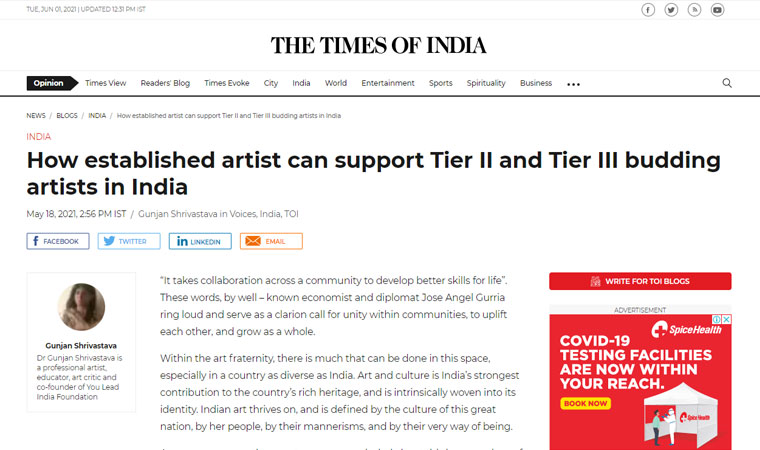How established artist can support Tier II and Tier III budding artists in India
“It takes collaboration across a community to develop better skills for life”. These words, by well – known economist and diplomat Jose Angel Gurria ring loud and serve as a clarion call for unity within communities, to uplift each other, and grow as a whole.
Within the art fraternity, there is much that can be done in this space, especially in a country as diverse as India. Art and culture is India’s strongest contribution to the country’s rich heritage, and is intrinsically woven into its identity. Indian art thrives on, and is defined by the culture of this great nation, by her people, by their mannerisms, and by their very way of being.
As we move across the country, we are reminded about this in every piece of art that adorns the walls, the workshops, and the streets. From Pattachitra in Odisha and Pithora in tribal Gujarat, to Warli in rural Maharashtra and Muggulu in Andhra Pradesh, India’s art environment is brimming with possibilities, ready to explore. However, the unfortunate reality that we can no longer afford to ignore, is the limited opportunities available to talented artists in rural India.
Also, there is a blend of many vulnerable contemporary artists who lack exposure belonging to these rural pockets.
Some of the many challenges faced by these artists in such Tier II and Tier III cities include the lack of exposure to new mediums, ideas, and the evolving art world.
There is also an inherent lack of awareness about the opportunities that are available, as well as guidance and inspiration. Another hindrance to their growth is the inability to communicate the meaning behind their works, as well as the lack of skills required to understand how to monetize their works.
Owing to an ease of access to art galleries, audiences, and materials, artists in metros and Tier I cities in India, do enjoy a competitive edge over their counterparts from Tier II and Tier III cities.We do realise that there is an urgent need to step up and build the bridges between disparate groups that is necessary for communities and cultures to move forward.
Through this, there is plenty of opportunity to work together, to build a powerful community of artists that is driven by mutual support. Within the pool of established artists in India, we need to come together, to create a co-learning and co-working environment where strengths can be exchanged. By understanding the challenges that exist, we can work step by step to create a community that is defined by inclusion.
Among the key ways in which we can work towards this goal include:
Create Digital Awareness: The digital wave has permeated every aspect of our lives and has revolutionized the way we work. As artists, this has opened up a plethora of options for us to leverage in order to take our works to the audiences. In our endeavor to bring artists from across the country on to the same playing field, we need to educate them about the opportunities that are available. Be it helping them create a virtual gallery, or an online portfolio, or host an online exhibition, there is tremendous scope to explore digital platforms.
Increase Exposure: Among urban artists there is definitely increased exposure which can be passed on to those from other parts of the country. One way of doing this could be through sharing of works. Across social media, #ArtistsSupportPledge is a great way to share contemporaries’ works, expose them to a wider market, and increase awareness about their styles.
Bridge the gaps in expression: Diversity defines India, and is seen in the number of languages spoken. As per official data, India is home to over 19,500 languages or dialects which are spoken in India as mother tongues. The downside to this, is that artists who have not been exposed to or studied in a global medium often find it difficult to express what their works stand for. As urban artists, we have the capabilities to bring the two together, and blend our knowledge of universally accepted languages with that of the artist’ mother tongue to bridge the expression gaps. In the long run, this will be beneficial in helping artists explain their works, and increase interest in them.
Build exhibition opportunities: Exhibitions are a proven way to increase awareness about your works, and yourself as a brand. Taking this concept to Tier 2 and Tier 3 artists, we can definitely work along with them to create exhibition opportunities. Travelling exhibitions as a concept is a great way to take their works across the country, and increase their reach, as well as create awareness about the opportunities available outside of their area of operations.
Improve access to materials: Among urban artists, there is a definite advantage, when it comes to accessing materials and knowledge resources. Bringing this to the community at large, we need to come together to create an artist pool of volunteers and mentors where there are synergies exchanged. By means of residencies and camps, we can help collaborate, communicate, and create magnificent works, and build a strong art community.
If we can create these mechanisms, they will reward us by changing our art community in ways both practical and transformational. As seen in the various means of being able to help grow the artist community, a common factor is increased collaboration and networking. Co-learning and collaboration is a two way experience, and it can prove to be enriching even for the established urban artist. We need to remember that alone we are strong, but together we are stronger, and with this thought in mind, work towards an inclusive art family.


Leave a Reply